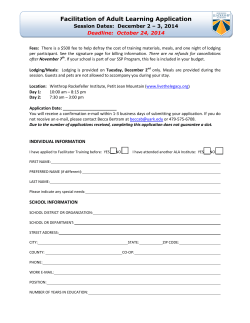
Basic Risk Management Facilitation Methods
Annex I: Methods & Tools ICH Q9 QUALITY RISK MANAGEMENT Annex I.1 Basic Risk Management Facilitation Methods prepared by some members of the ICH Q9 EWG for example only; not an official policy/guidance July 2006, slide 1 Annex I: Methods & Tools ICH Q9 QUALITY RISK MANAGEMENT I.1: Basic risk management facilitation methods Flowchart Check Sheets Process mapping Cause and Effect Diagrams (Ishikawa / fish bone) They might be helpful to support risk identification prepared by some members of the ICH Q9 EWG for example only; not an official policy/guidance July 2006, slide 2 Annex I: Methods & Tools ICH Q9 QUALITY RISK MANAGEMENT I.1: Basic risk management facilitation methods Flowcharts Start Activity Pictorial representations of a process Activity Decision Yes Result No Action Breaking the process down into its constituent steps prepared by some members of the ICH Q9 EWG for example only; not an official policy/guidance July 2006, slide 3 Annex I: Methods & Tools ICH Q9 QUALITY RISK MANAGEMENT I.1: Basic risk management facilitation methods Check sheets Present information in an efficient, clear format May be accomplished with a simple listing of items prepared by some members of the ICH Q9 EWG for example only; not an official policy/guidance July 2006, slide 4 Annex I: Methods & Tools ICH Q9 QUALITY RISK MANAGEMENT I.1: Basic risk management facilitation methods Process mapping The indicators may be selected based on unit operations Shows how they are interrelated Potential Areas of Use(s) / outcomes Provides a clear and simple visual representation of involved steps Facilitates understanding, explaining and systematically analyzing complex processes and associated risks A pre-requisite for the use of some other tools ICH Q9 prepared by some members of the ICH Q9 EWG for example only; not an official policy/guidance July 2006, slide 5 Annex I: Methods & Tools ICH Q9 QUALITY RISK MANAGEMENT EXAMPLE I.1: Basic risk management facilitation methods Air Dispensing Fluidized Bed Dryer Sieving Scale Granulation Process mapping Magnesium Stearate Air Blending Sieving Tabletting Packaging Coating prepared by some members of the ICH Q9 EWG for example only; not an official policy/guidance F. Erni, Novartis Pharma July 2006, slide 6 Annex I: Methods & Tools ICH Q9 QUALITY RISK MANAGEMENT I.1: Basic risk management facilitation methods Cause and Effect Diagrams (Ishikawa / fish bone) Environment People Materials Problem statement Equipment Measurement System prepared by some members of the ICH Q9 EWG for example only; not an official policy/guidance Methods July 2006, slide 7 Annex I: Methods & Tools ICH Q9 QUALITY RISK MANAGEMENT I.1: Basic risk management facilitation methods Cause and Effect Diagrams (Ishikawa / fish bone) To associate multiple possible causes with a single effect Constructed to identify and organize possible causes for it Primary branch: represents the effect Major branch: corresponds to a major cause Minor branch: correspond to more detailed causal factors prepared by some members of the ICH Q9 EWG for example only; not an official policy/guidance July 2006, slide 8 Annex I: Methods & Tools ICH Q9 QUALITY RISK MANAGEMENT I.1: Basic risk management facilitation methods Cause and Effect Diagrams (Ishikawa / fish bone) How to perform? Define and agree a precise problem statement (put as “head” of fish bone) Think “What could be its causes?” for each node Add it to the “fish bone” diagram For each line pursue back to its root cause Consider splitting up overcrowded sections “bones” Consider which potential root causes and the need for further investigation on them Environment Equipment prepared by some members of the ICH Q9 EWG for example only; not an official policy/guidance People Materials Measurement System Problem statement Methods July 2006, slide 9 Annex I: Methods & Tools ICH Q9 QUALITY RISK MANAGEMENT EXAMPLE I.1: Basic risk management facilitation methods Cause and Effect Diagrams (Ishikawa / fish bone) C. Kingery, The Six Sigma Memory Jogger II prepared by some members of the ICH Q9 EWG for example only; not an official policy/guidance July 2006, slide 10 Annex I: Methods & Tools ICH Q9 QUALITY RISK MANAGEMENT EXAMPLE I.1: Basic risk management facilitation methods Coating Drying Milling Analytical Temperature Spray Rate Redrying Pan Speed Temp Time Milling Gun Distance RH Temperature Air Flow Atomizing Air Pressure Operator Temp/RH Operator Training Other Sampling Porosity Mill Speed Shock Cycle Precompressing Main Compressing Temp Press Speed Spray Rate P.S. Process Conditions LOD HPMC Spray Pattern Tooling Feed Frame P.S. Scrape Down Compressing Methoxyl Hydroxyl P.S. LOD Chopper Speed Other Mixer Speed Syloid Lactose Endpoint Coating Power Time Tablet Hardness Age Binder Feeder Speed Method Drug Substance Water Punch Penetration Depth Plant Factors Screen Size Raw Materials Granulation prepared by some members of the ICH Q9 EWG for example only; not an official policy/guidance Cause and Effect Diagram for Tablet Hardness © Alastair Coupe, Pfizer Inc. July 2006, slide 11
© Copyright 2025
















